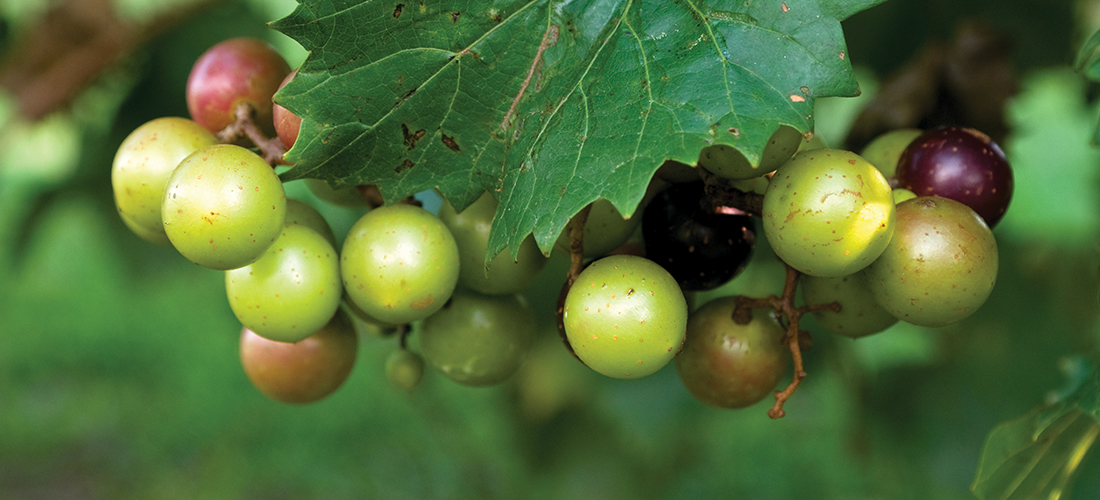
The magic of muscadines
By Jan Leitschuh
As a Wisconsin transplant who fell in love with the South almost 40 years ago, I had never tasted a muscadine grape until the early 2000s.
It wasn’t until I bought a little patch of land here that I came to know the unique fall grape born in the Tar Heel State. In fact, it’s our state fruit.
The muscadine is often called the “grape of the South.” Though widely cultivated now in the southern and eastern United States, Vitis rotundifolia has a wild, wild past. Gathered for centuries for jams, ciders, jellies, preserves and homemade wine, the first reported muscadine was the “Mother Vine,” a golden-green variety of muscadine vine discovered by Sir Walter Raleigh’s colony. The colonists delighted in the abundance of these sweet treats tangling coast, woodland and riverbank.
By the way, the “Mother Vine” still lives in coastal Manteo, stewarded by an elderly couple on private land. Over 400 years old, she is America’s oldest cultivated grapevine. At one point, “Mother” covered over half an acre, with a trunk-like base 2 feet thick. Her wild gold-bronze fruits were named for the Scuppernong River, which runs into the Albemarle Sound in eastern North Carolina. Scuppernong is the original variety discovered growing in the wild.
While the term muscadine encompasses both the greenish-bronze scuppernongs as well as the purple-black grapes, the moniker “scuppernong” is reserved for the fairer grape alone.
My new property is nestled beside a town so tree-filled and tangled it was originally named Vineland before John T. Patrick renamed it Southern Pines. The raw land was filled with muscadines. Threaded through the wooded edges of my piece of heaven were exceedingly vigorous grapevines, wild and snarled, which I left alone out of curiosity and, frankly, a healthy live-and-let-live indolence. It’s a lot of work, tearing out grapevines, and expensive, too — a bulldozer or trackhoe is needed to uproot an old vine.
We co-existed. Cardinals built their nests in the protective snarls, the light green leaves sparkled in the woodland fringes, and the vines did their viniferous thing.
Come August, the vines were heavy with fruit. The leaves shaded to gold. The birds grew excited. It became inadvisable to park under the vine-bearing trees. The vines began to shed ripe grapes, and the birds shed the remainders of ripe grapes.
I had to see what the excitement was about. I’d heard how old country farmhouses kept a bowl of muscadines on the kitchen table in the fall, something tasty to grab and snack on. Or that every third Southern backyard had a cultivated muscadine. I reached out to my wild vines and sampled some very sour greenish-gold grapes — and some sweet and strangely intriguing black grapes.
Biting in, the thick skin was a surprise. To one raised on common green grapes from the grocery, these feral globes were of a different ilk, larger and hanging solo rather than in a tight cluster. Likewise, the five large seeds each grape contained got in the way of the juicy pulp.
It was not love at first bite. And yet, the grapes were curiously addictive. By the end of that first fall, I found myself craving their unique, dusky taste.
Only later did I learn the intriguing, heart-healthy benefits of this curious Southern fruit.
Muscadine grapes, it turns out, are antioxidant superstars.
Nature’s healthiest grape, muscadines have, by a large margin, the highest levels of antioxidants. We are talking off the charts healthy. One could even pull out that hoary label “superfood.” Studies show that the main compounds, ellagic acid and resveratrol (you know, the redwine antioxidant), can play a useful role in preventing cancer, heart disease and hyperlipidemia (high cholesterol). They forestall free radical damage and inflammation, staving off aspects of the aging process. Muscadines can also help inhibit the growth of cancerous cells by inducing apoptosis, or cell death.
Beneficial for hypertensive people, especially people also suffering from high cholesterol, muscadine phytochemicals can help regulate blood pressure. Muscadine grape skin extract inhibits the cell growth in prostate cancer. Muscadines also enhance general immunity, just what is needed heading into fall’s chilly storms.
Other nutrients found in muscadines include the antioxidant quercetin, vitamin C, potassium, vitamin B, and trace minerals. Muscadines are naturally fat-free — a half-cup serving is 65 calories — cholesterol-free and low in sodium. They are fiber rich, too, full of the insoluble fiber doctors urge us all to consume.
Unlike other grapes, which are bred to be seedless, muscadines contain both seeds and those thick skins. I soon discovered many people spit out the skin and seeds. Unfortunately, 90 percent of the nutritional health benefits of the grapes are in the skin and seeds.
Based on the ORAC (Oxygen Radical Absorbance Capacity, a lab test to measure antioxidants in food), muscadine grapes have been clocked as high as 6,800 per 100 grams, compared to 739 for red grapes. The muscadine grape skins alone have about six to eight times as much antioxidant capacity as whole blueberries.
Yet muscadine seeds are the true antioxidant superstars. Seeds contain the highest antioxidant levels in the grape, followed by the skin and pulp. The seeds are dense with phenolics, containing 87 percent health-promoting antioxidant compounds. That’s crazy. The skins, the second-highest source, contain around 11 percent, and muscadine pulp has only 1.6 percent. Researchers have identified a total of 88 different antioxidant compounds in muscadine grapes, 43 of which occurred in the seeds. Seventeen of the compounds are unique to muscadine grapes. Muscadine grapes work this magic via an extra set of chromosomes, with genes that produce a unique balance of phytonutrients virtually absent in other grapes.
The seeds need to be chewed to release their health benefits, but if you aren’t fond of munching on gritty grape seeds (tasteless, I might add), there are other ways to ingest. Unwilling to spit out and waste the deep nutrition of the seeds, I like to wash and freeze a batch of grapes on a tray, then bag the grapes for later fall and winter smoothies. A few frozen grapes tossed into many smoothie recipes sweeten things up naturally, and a good blender makes short work of the seeds and skins. Vôila! Drinking my nutrition.
Another way to capture the seed nutrition is to pay big bucks for a muscadine grape supplement, sold online or in health food stores for $30-$45. Some clever wineries, understanding how valuable their waste product actually was, discovered ways to dry and powder the seeds, encapsulating the result and offering it for sale. Why buy resveratrol pills for inflammation control? Eat muscadines and get the whole panoply of benefits.
For cooking, fresh muscadines are often de-seeded, and the pulp and hulls cooked. The resulting preserve is used in breads, cakes and pies. To feature a taste of place, regional chefs enjoy crafting unique dishes with muscadine flavors. Their offerings often feature pork, a fellow fall flavor. A quick perusal of online recipes turns up such dishes as Muscadine-Honey Glazed Pork Chops, or Slow-Cooker Muscadine and Cranberry Pork Roast. Beef gets a showing, too, such as Scuppernong-Glazed Bourbon Beef Ribs with Tasso. Grilled Sausage with Herbed Muscadine Sauce is drool-worthy.
Some folks make a fall chutney or spicy muscadine sauce with cloves, allspice, cinnamon and mace. I’d be tempted to add a tiny bit of heat to that sweet, perhaps a small nugget of jalapeño worked in. Muscadine mojitos sound perfect for those glorious Indian summer weekends or perhaps Muscadine Sangria. All Google-able.
Muscadine swirl cheesecake is inventive, and appears to take cream cheese and mascarpone to a whole new level. A creamy goat cheese log with muscadine jelly alongside is as simple as party treats get. Scuppernong pound cake evokes church dinners in the fall. Muscadines in port wine spooned over ice cream intrigues.
You can grow your own muscadines to easily cover a trellis or arbor. They are sturdy, vigorous, native and virtually pest-free (unless you count birds). Lacking vines of your own, search for pints of muscadines at farmers markets, in Sandhills Farm to Table Co-op boxes and farm stands. There are also many muscadine vineyards located throughout our state, especially down east. Some grocery stores may even feature them for a very short time.
Store muscadines in a covered shallow container in the refrigerator for best results. Do not wash them until you are ready to use them — this prevents the muscadines from degrading. The N.C. Cooperative Extension says they will keep for up to a week depending upon their original condition, but are best if used within a few days. Inspect the grapes periodically and remove ones that show signs of decay. But honestly, I mostly keep mine on a cool counter, or freeze.
To cook or preserve muscadines, sort, stem and wash. Separate pulp from hulls, saving both. Heat the pulp to boiling, to separate seed. I use the back of a spoon to push the cooked pulp through a strainer. Mix juice with hulls and boil until the hulls are tender. Mix softened hulls with seed-free pulp. Add one part sugar to six parts grapes, stirring until sugar is dissolved. Cool and then either process or use as a sauce in some creative manner of your own.
This month, see if you can track down this edible piece of North Carolina heritage. If the taste doesn’t grow on you, perhaps the health benefits will. PS
Jan Leitschuh is a local gardener, avid eater of fresh produce and co-founder of the Sandhills Farm to Table Cooperative.





